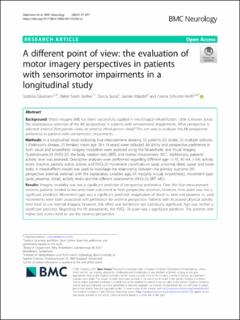Please use this identifier to cite or link to this item:
https://doi.org/10.21256/zhaw-25903Full metadata record
| DC Field | Value | Language |
|---|---|---|
| dc.contributor.author | Gäumann, Szabina | - |
| dc.contributor.author | Gerber, Rahel Sarah | - |
| dc.contributor.author | Suica, Zorica | - |
| dc.contributor.author | Wandel, Jasmin | - |
| dc.contributor.author | Schuster-Amft, Corina | - |
| dc.date.accessioned | 2022-10-28T13:32:32Z | - |
| dc.date.available | 2022-10-28T13:32:32Z | - |
| dc.date.issued | 2021 | - |
| dc.identifier.issn | 1471-2377 | de_CH |
| dc.identifier.uri | https://digitalcollection.zhaw.ch/handle/11475/25903 | - |
| dc.description.abstract | Background: Motor imagery (MI) has been successfully applied in neurological rehabilitation. Little is known about the spontaneous selection of the MI perspectives in patients with sensorimotor impairments. What perspective is selected: internal (first-person view), or external (third-person view)? The aim was to evaluate the MI perspective preference in patients with sensorimotor impairments. Methods: In a longitudinal study including four measurement sessions, 55 patients (25 stroke, 25 multiple sclerosis, 5 Parkinson’s disease; 25 females; mean age 58 ± 14 years) were included. MI ability and perspective preference in both visual and kinaesthetic imagery modalities were assessed using the Kinaesthetic and Visual Imagery Questionnaire-20 (KVIQ-20), the body rotation task (BRT), and mental chronometry (MC). Additionally, patients’ activity level was assessed. Descriptive analyses were performed regarding different age- (< 45, 45–64, > 64), activity levels (inactive, partially active, active), and KVIQ-20 movement classifications (axial, proximal, distal, upper and lower limb). A mixed-effects model was used to investiage the relationship between the primary outcome (MI perspective: internal, external) with the explanatory variables age, MI modality (visual, kinaesthetic), movement type (axial, proximal, distal), activity levels and the different assessments (KVIQ-20, BRT, MC). Results: Imagery modality was not a significant predictor of perspective preference. Over the four measurement sessions, patients tended to become more consistent in their perspective selection, however, time point was not a significant predictor. Movement type was a significant predictor: imagination of distal vs. axial and proximal vs. axial movements were both associated with preference for external perspective. Patients with increased physical activity level tend to use internal imagery, however, this effect was borderline not statistically significant. Age was neither a significant precictor. Regarding the MI assessments, the KVIQ- 20 score was a significant predictor. The patients with higher test scores tend to use the external perspective. Conclusion: It is recommended to evaluate the spontaneous MI perspective selection to design patient-specific MI training interventions. Distal movements (foot, finger) may be an indicator when evaluating the consistency of the MI perspective in patients with sensorimotor impairments. | de_CH |
| dc.language.iso | en | de_CH |
| dc.publisher | BioMed Central | de_CH |
| dc.relation.ispartof | BMC Neurology | de_CH |
| dc.rights | http://creativecommons.org/licenses/by/4.0/ | de_CH |
| dc.subject | Motor imagery | de_CH |
| dc.subject | Motor imagery perspective | de_CH |
| dc.subject | Neurorehabilitation | de_CH |
| dc.subject | Sensorimotor impairment | de_CH |
| dc.subject.ddc | 616.8: Neurologie und Krankheiten des Nervensystems | de_CH |
| dc.title | A different point of view : the evaluation of motor imagery perspectives in patients with sensorimotor impairments in a longitudinal study | de_CH |
| dc.type | Beitrag in wissenschaftlicher Zeitschrift | de_CH |
| dcterms.type | Text | de_CH |
| zhaw.departement | Gesundheit | de_CH |
| zhaw.organisationalunit | Institut für Physiotherapie (IPT) | de_CH |
| dc.identifier.doi | 10.1186/s12883-021-02266-w | de_CH |
| dc.identifier.doi | 10.21256/zhaw-25903 | - |
| dc.identifier.pmid | 34315411 | de_CH |
| zhaw.funding.eu | No | de_CH |
| zhaw.issue | 297 | de_CH |
| zhaw.originated.zhaw | Yes | de_CH |
| zhaw.publication.status | publishedVersion | de_CH |
| zhaw.volume | 21 | de_CH |
| zhaw.publication.review | Peer review (Publikation) | de_CH |
| zhaw.author.additional | No | de_CH |
| zhaw.display.portrait | Yes | de_CH |
| Appears in collections: | Publikationen Gesundheit | |
Files in This Item:
| File | Description | Size | Format | |
|---|---|---|---|---|
| 2021_Gaeumann-etal_Different-point-vue-motor-imagery-perspectives-sensorimotor-impairments.pdf | 1.31 MB | Adobe PDF |  View/Open |
Show simple item record
Gäumann, S., Gerber, R. S., Suica, Z., Wandel, J., & Schuster-Amft, C. (2021). A different point of view : the evaluation of motor imagery perspectives in patients with sensorimotor impairments in a longitudinal study. BMC Neurology, 21(297). https://doi.org/10.1186/s12883-021-02266-w
Gäumann, S. et al. (2021) ‘A different point of view : the evaluation of motor imagery perspectives in patients with sensorimotor impairments in a longitudinal study’, BMC Neurology, 21(297). Available at: https://doi.org/10.1186/s12883-021-02266-w.
S. Gäumann, R. S. Gerber, Z. Suica, J. Wandel, and C. Schuster-Amft, “A different point of view : the evaluation of motor imagery perspectives in patients with sensorimotor impairments in a longitudinal study,” BMC Neurology, vol. 21, no. 297, 2021, doi: 10.1186/s12883-021-02266-w.
GÄUMANN, Szabina, Rahel Sarah GERBER, Zorica SUICA, Jasmin WANDEL und Corina SCHUSTER-AMFT, 2021. A different point of view : the evaluation of motor imagery perspectives in patients with sensorimotor impairments in a longitudinal study. BMC Neurology. 2021. Bd. 21, Nr. 297. DOI 10.1186/s12883-021-02266-w
Gäumann, Szabina, Rahel Sarah Gerber, Zorica Suica, Jasmin Wandel, and Corina Schuster-Amft. 2021. “A Different Point of View : The Evaluation of Motor Imagery Perspectives in Patients with Sensorimotor Impairments in a Longitudinal Study.” BMC Neurology 21 (297). https://doi.org/10.1186/s12883-021-02266-w.
Gäumann, Szabina, et al. “A Different Point of View : The Evaluation of Motor Imagery Perspectives in Patients with Sensorimotor Impairments in a Longitudinal Study.” BMC Neurology, vol. 21, no. 297, 2021, https://doi.org/10.1186/s12883-021-02266-w.
Items in DSpace are protected by copyright, with all rights reserved, unless otherwise indicated.